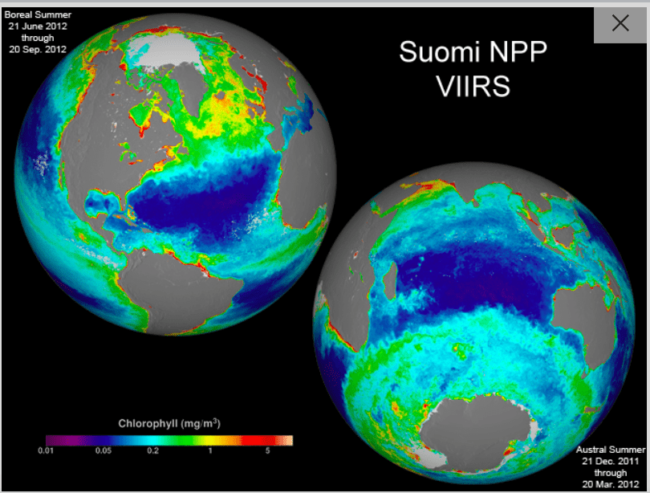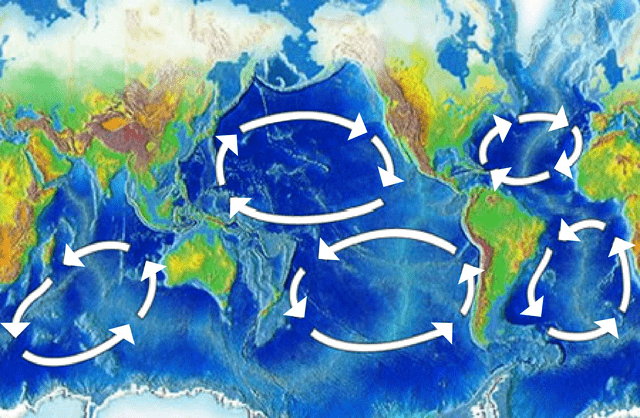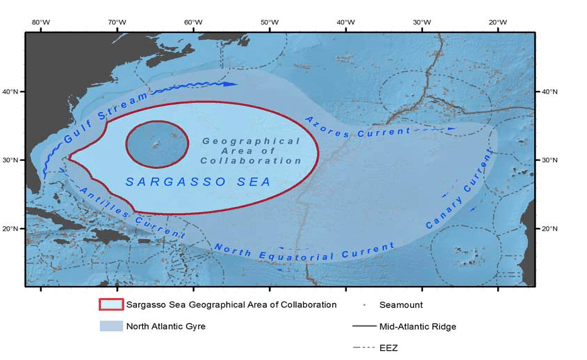SUMMARY: GREENING THE NORTHERN AND SOUTHERN OCEANS
This article argues that the “Iron Hypothesis” consisting of the appropriate Iron filtrate, must now be developed and deployed on a massive scale in the Earth’s oceans in order to create huge plankton blooms in the Earth’s oceans to pull CO2 out of the atmosphere. In view of the alarming fall 2018 IPCC report, we have from five to twelve years to make a decisive impact against growing climate change unless such negative emissions are used. Undoubtedly, many other mitigation methods will have to be used as well since are simply running out of time.
INTRODUCTION: THE GREAT RED DRAGON– A PERSONAL JOURNEY
On a recent train trip in the fall of 2018, my journey took me past three major metro areas on the United States Eastern Seaboard—Baltimore, Philadelphia and New York City. On the shuttle north, I saw were the interstates were literally jammed, almost bumper to bumper, with SUVS, and even Humvees containing holiday travelers—it was the Thanksgiving holiday in the states which is the busiest travel time of the year in America.
Watching traffic claw along, I was struck by how large the vehicles driven by Americans had become: huge vehicles like the gas guzzling Expeditions, Sequoias, Suburbans, Tacomas, Yukons and Armadas—often containing one driver—clogged the highways, sometime roaring past and often slowed to a snail pace by the huge volume of traffic. At one point, as I looked far ahead on the highway, I dubbed the innumerable red tail lights the Great Red Dragon, a huge glowing red, collective and gluttonous monster on the road. I marveled to myself, thinking that, “when I was a kid, we called vehicles this big ‘milk trucks’ or ‘hearses!” The image of a hearse stuck in my mind since I thought that I was, in fact, watching the forthcoming death of the world.
This is because, nearly three decades after the first Earth Summit in Rio (1992), which created the Framework Convention on Climate Change (UNFCCC), calling for global carbon cuts, I could see with my own eyes that the gluttonous consumption of carbon fuels continues unabated and even seems to be accelerating. Despite the ample efforts to cut the use of carbon by the UNFCC as well as the voluminous warnings around the world concerning the dire consequences of burning more carbon fuels, the glowing Red Dragon was proof we had not made much progress.
In fact, according to the latest and alarming report by U.N. Intergovernmental Panel on Climate Change (IPCC), issued a month before, the world has just over a decade to get climate change under control.[1] Furthermore, the report states that of negative emissions may be the only way to keep global temperatures below 1.5 C.[2] specifically, the report states:
“All pathways that limit global warming to 1.5°C with limited or no overshoot project the use of carbon dioxide removal (CDR) on the order of 100–1000 GtCO2 over the 21st century. CDR would be used to compensate for residual emissions and, in most cases, achieve net negative emissions to return global warming to 1.5°C following a peak (high confidence).”[3]
In view of this, I propose only negative emissions can save or even help us now, since it seems obvious that Americans—and the rest of developed world—seem fully intent on sucking every last drop of oil out of the ground and consuming it in the ongoing Red Dragon’s oil orgy of conspicuous and gluttonous consumption. Unfortunately, the time has long passed when only “pure” policy choices, such as the voluntary cutting of carbon fuel consumption, were enough to save ourselves or our planet.
THE PROPOSAL: GREEN THE SEAS
The October 2018 IPCC report gives support for the deployment and use of negative emissions; in doing so, the rather obvious ethical rule of application is that such mitigation or sequestration technologies should not be deployed if the actual damage that they cause is greater than the growing danger and increasing devastating consequences of continuing, unabated global climate change.
In short, there is now a cruel yet unavoidable ethical calculus of cost-benefits calculations concerning the benefits and inevitable negative consequences of simply doing nothing, such as droughts, wildfires migrations and increasing extinction events.
THE GLOBAL DEVELOPMENT AND DEPLOYMENT OF THE IRON HYPOTHESIS: NOW OR NEVER.
The Iron Hypothesis, developed by Oceanographer Dr. John Martin, posits that the placing of iron in the ocean will lead to massive plankton blooms which, in turn absorbs CO2 from the atmosphere.[4] Preliminary testing—and there has ONLY been preliminary testing of this idea, indicates that it can work in the right configuration of chemistry, iron filtrate and natural conditions.[5] The Earth is 70% ocean and this vast area must now be enlisted in our sheer struggle to survive.
Given this, the time has come, due to the increasing severity of extreme climate change, to rapidly develop and deploy, after intense and accelerated research, the appropriate methodologies, needed to apply the Iron Hypothesis to the oceans. Several test pilot projects may be needed to develop the appropriate iron filtrate that can be absorbed by plankton in a variety of complex ocean eco-systems. Once this is achieved, then large scale deployment of the actual Iron Hypothesis can begin and continue on larger and larger scales; the emphasis first should be on where there are already massive plankton blooms in the upper latitudes of the Northern and Southern oceans (see enclosed Satellite photo, below). Fortunately, or unfortunately, these seas are crossed by literally thousands of ships monthly. The strategies, methods and technologies should be rapidly developed to allow these ships to seed the oceans, as part of their much needed carbon offsetting.
If these efforts prove inadequate, then specialized ships should be developed and deployed using a minimum carbon footprint—even the so-called tall (sail) ships could be employed; there would be no shortage of volunteer seamen and women to crew such ships for a duration at sea. Also, attempts should be made to deploy the appropriate iron filtrate to seed the oceans FROM THE SHORES, especially from the beaches of southern Argentina or Ecuador and Peru where the huge Antarctica and smaller Trans-Pacific plankton blooms seem to originate.[6]
Such seeding of the seas with iron filtrate could possibly be most effective in those sections of the Oceans such as the Sargasso Sea, east of the 40th meridian, beyond the “Biologically Significant Marine Areas (EBSAs) and the “Geographical Area of Collaboration” (See map) that form a natural oceanic gyre; the advantages of such gyres are that they are far away from inhabited coasts, for the most part, and large Plankton booms may flourish within these ring-like systems. In fact, climate change, as well as growing and floating garbage dumps, are already degrading such unique areas of the ocean. We need to rapidly experiment with seeding such gyres, as well as other areas of the ocean—to see if they will create Plankton blooms with any self-regulating or regenerating properties.
The obstacles are enormous but so too are the growing climate dangers. The Antarctic circumpolar current may be the best place to begin testing and deployment of large scale ocean seeding. When added to the Northern and Southern oceans, such as the critical Antarctic circumpolar current, all of these areas cover very large part of the seven seas.

It should be pointed out that such a commitment to the massive deployment of the Iron hypothesis will create hundreds of thousands of jobs throughout the world, especially in developing countries where the need for such employment is greatest. An Earth Armistice, discussed on a separate MAHB blog, could help pay for the expenses involved.
CONCLUSION: WE ARE SIMPLY RUNNING OUT OF TIME
This article argues that the Iron Hypothesis consisting of the appropriate iron filtrate, should be developed and deployed on a massive scale in the Earth’s oceans. Undoubtedly, many other mitigation methods will have to be used as well. Yet, in view of the alarming 2018 IPCC report, we are simply running out of time to make a decisive impact against growing climate change unless such negative emissions are used. If we fail, then the fiery Red Dragon of climate change may consume us all.

Thomas Boudreau, PhD is Interdisciplinary Professor of Conflict Analysis at Salisbury University in Maryland. Boudreau is also a Senior Fellow with the Institute for Resource and Security Studies in Cambridge, Massachusetts. From 1982-87, he served as a former private advisor to the Executive Office of the UN Secretary General, and author of Sheathing the Sword: The UN Secretary General and the Prevention of International Conflict (1991).
The MAHB Blog is a venture of the Millennium Alliance for Humanity and the Biosphere. Questions should be directed to joan@mahbonline.org
[1] (Washington Post, Oct. 7, 2018 at: https://www.washingtonpost.com/energy-environment/2018/10/08/world-has-only-years-get-climate-change-under-control-un-scientists-say/
[2] See: https://www.ipcc.ch/report/sr15. Or, https://www.ipcc.ch/news_and_events/pr_181008_P48_spm.shtml
[3] Ibid, See: https://www.ipcc.ch/report/sr15, Also: Summary for Policymakers, C-3 at: https://www.ipcc.ch/pdf/special-reports/sr15/sr15_spm_final.pdf
[4] Martin, J. H., et al. (1994). Testing the iron hypothesis in ecosystems of the equatorial Pacific Ocean. Nature, 371(6493), 123.
[5] See Boudreau, T, (2017), “The Earth Atmosphere as a Global Trust,” Environmental and Earth Law Journal
[6] Ibid., Also see: https://atmosphereasaglobaltrust.com/
The views and opinions expressed through the MAHB Website are those of the contributing authors and do not necessarily reflect an official position of the MAHB. The MAHB aims to share a range of perspectives and welcomes the discussions that they prompt.
